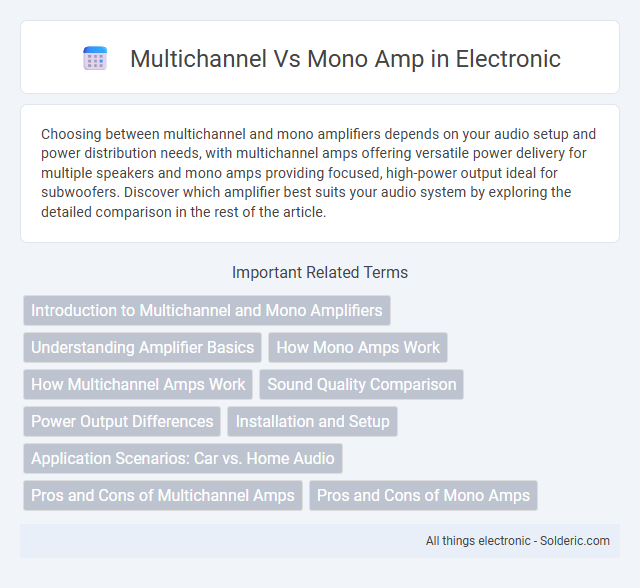Choosing between multichannel and mono amplifiers depends on your audio setup and power distribution needs, with multichannel amps offering versatile power delivery for multiple speakers and mono amps providing focused, high-power output ideal for subwoofers. Discover which amplifier best suits your audio system by exploring the detailed comparison in the rest of the article.
Comparison Table
| Feature | Multichannel Amplifier | Mono Amplifier |
|---|---|---|
| Number of Channels | Multiple channels (typically 2-8) | Single channel |
| Use Case | Powering multiple speakers or zones | Driving a single subwoofer or high-power speaker |
| Power Output | Moderate power per channel | High power output to one channel |
| Flexibility | High--supports complex sound systems | Limited to single speaker application |
| Sound Quality | Balanced across multiple channels | Optimized for deep bass and subwoofers |
| Installation | More complex wiring and setup | Simple wiring |
| Cost | Generally more expensive | Usually cost-effective for single use |
Introduction to Multichannel and Mono Amplifiers
Multichannel amplifiers deliver power to multiple speakers or channels simultaneously, ideal for creating immersive audio setups with separate sound zones. Mono amplifiers provide a single channel of high-power output, typically used for driving subwoofers to enhance bass performance. Your choice depends on whether you need versatile multi-speaker amplification or focused mono bass power in your audio system.
Understanding Amplifier Basics
Multichannel amplifiers deliver power through multiple channels, allowing you to drive several speakers or subwoofers independently for improved audio distribution in your vehicle or home system. Mono amps, designed to power a single channel, excel at driving subwoofers by providing high power output and reduced distortion. Understanding amplifier basics helps you choose the right type, ensuring optimal sound quality and system performance tailored to your audio setup.
How Mono Amps Work
Mono amps operate by delivering a single, powerful channel of amplified sound, specifically designed to drive subwoofers with maximum power and clarity. These amplifiers use a dedicated power supply and output stage optimized for low-frequency signals, ensuring less distortion and higher efficiency compared to multichannel alternatives. Their focused design makes them ideal for enhancing bass performance in car audio systems.
How Multichannel Amps Work
Multichannel amplifiers distribute power to multiple speakers by using separate amplification channels within a single unit, allowing independent control over each channel. They efficiently power full home theater systems or multi-room audio setups by delivering tailored output levels to components such as front, rear, and subwoofer speakers. This architecture reduces wiring complexity and optimizes sound quality by matching the power output to the specific demands of each speaker channel.
Sound Quality Comparison
Multichannel amplifiers deliver enhanced sound quality by powering each speaker individually, ensuring precise audio control and reduced distortion compared to mono amps. Mono amps focus on driving a single channel, often providing higher power output suitable for subwoofers but with less versatility in sound stage and clarity. Your audio system benefits from multichannel amps when aiming for detailed, immersive sound reproduction across multiple speakers.
Power Output Differences
Multichannel amplifiers typically deliver lower power output per channel compared to mono amplifiers, which are designed to provide higher wattage to a single channel for driving subwoofers. Mono amps often produce cleaner, more robust power suitable for low-frequency speakers, ensuring minimal distortion at high volumes. Multichannel amps balance power distribution across multiple channels, making them ideal for full-range speaker systems but generally unable to match the concentrated power output of dedicated mono amps.
Installation and Setup
Multichannel amplifiers simplify installation and setup by integrating multiple amplifier channels into a single unit, reducing wiring complexity and saving space in the vehicle. Mono amplifiers require separate units for each channel, which can increase installation time and the need for additional wiring and mounting points. Choosing a multichannel amp often results in a cleaner, more streamlined setup, especially for those seeking to power multiple speakers and subwoofers simultaneously.
Application Scenarios: Car vs. Home Audio
Multichannel amplifiers excel in car audio systems by delivering power to multiple speakers independently, enhancing surround sound and clarity in compact spaces. Mono amplifiers are preferred in home audio setups for driving subwoofers, providing deep, focused bass essential for immersive listening experiences. Choosing between multichannel and mono amps depends on the speaker configuration and acoustic environment of the car or home.
Pros and Cons of Multichannel Amps
Multichannel amps deliver the convenience of powering multiple speakers with a single unit, simplifying installation and reducing space requirements. You gain improved integration and potentially lower overall cost compared to using several mono amps, but multichannel amps may sacrifice some sound quality and power output stability on individual channels. Their design limits customization for each speaker, which can impact audio performance if your setup demands precise tuning or high power per channel.
Pros and Cons of Mono Amps
Mono amps deliver superior power and clarity for individual speakers, making them ideal for subwoofers and enhancing low-frequency performance. You benefit from efficient heat dissipation and simpler wiring, but the need for multiple units can increase system complexity and overall cost. Their dedicated design ensures precise tonal control, though they may lack the convenience of integrated channels found in multichannel amplifiers.
Multichannel vs Mono amp Infographic

 solderic.com
solderic.com